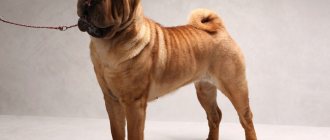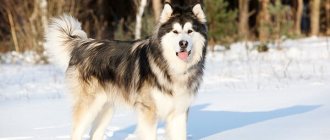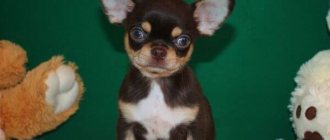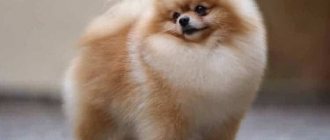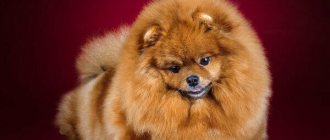Once you see long-haired Chihuahuas, they are not easy to forget.
Small dogs with soft, silky fur, grace, a cheerful nature and curiosity, have captivated dog lovers around the world.
But before you buy such a dog, you should know better about its character and the necessary care.
In our article we will tell you everything about this breed, and also show photos of its representatives.
History of the breed
The Chihuahua is a dog breed originally from Mexico . Its name is a modified transcription of the name of the Mexican state of Chihuahua.
The exact time of domestication of these dogs is unknown, but the history of the Chihuahua goes back thousands of years, because the first mentions of them are associated with the Mayan Indians.
It is believed that Chihuahuas lived in the wild for some time and were only discovered by the Mexicans at the end of the 19th century. The small dogs were liked by Americans who bought them at the market. This is how the breed came to the USA, and then to Europe.
Chihuahuas were first officially presented to the public in 1884 at a dog show held in Philadelphia.
NOTE!
In 1959, Fidel Castro gave two long-haired puppies to Nikita Khrushchev as a sign of friendship among peoples. This is how Chihuahuas ended up on the territory of the CIS.
Reviews
Ekaterina Koneva: “I keep 2 Chihuahua dogs: a male, a female. Loyal, sweet creatures. To avoid health problems for the dog, we visit veterinary clinics monthly. This is my favorite breed. Ideal for active people living in a small apartment.”
Egor Dezhnov: “It is better for small children not to buy such a dog. Carelessness of children leads to injuries to the pet. He forbade his youngest son to play with the dog without adult supervision. The Chihuahua is a very fragile animal.”
Elena Miskevich: “The long-haired Chihuahua is the best breed. The most affectionate creature I've ever met. The dog dotes on me and the children. The main thing is to be attentive to your pet’s health.”
Sincerity, cleanliness, energy - these qualities rightly characterize representatives of the Chihuahua breed.
With proper care, the dog's health will not cause concern. A Chihuahua will never disappoint its owner, the dog will delight with its presence and will become a full-fledged member of the family.
Description and standard
Long-haired Chihuahuas are small dogs with a compact body. Adults reach 15-23 cm at the withers, weight – 1-3 kg.
Below is a more detailed description of this breed.
The coat is thin and silky, and can be smooth or wavy. It is desirable to have a not too thick undercoat. On the ears, neck, back of the paws and tail, the hair is longer and forms feathers.
The head is round, apple-shaped. The muzzle tapers towards the nose, the transition to the forehead is wide and pronounced.
The lips are dry, tightly attached, and have a scissor or straight bite.
The eyes are round, convex, and dark in color.
The ears are erect, wide at the base and gradually tapering, with rounded tips.
The limbs are straight, set parallel. The paw pads are oval, small, elastic and developed.
The tail is of medium length, set high, thick at the base and tapering towards the end.
Main disadvantages
Any deviation from the accepted standard is a serious drawback. These include:
- flat or narrow skull;
- long and large muzzle;
- strong protrusion of the eyes or their small size;
- pointed or floppy ears;
- small neck;
- concave as well as curved spine;
- elongated body;
- misaligned jaw;
- small breast volume;
- completely thinning hair;
- sloping croup;
- narrow set of paws, as well as their curvature, etc.
Similar article: How to make a house for a Chihuahua with your own hands
The presence of the above deviations affects the cost of the animal.
Character traits
They are friendly, cheerful, active and curious dogs. They become attached to all family members, but they always choose one person as their main owner and remain faithful to him.
The Chihuahua always strives to be close to its owner, accompany him everywhere and easily adapts to his lifestyle and mood. When left alone, the dog becomes sad.
They expect the same attitude in return - they need constant attention and care. They strive to achieve them with all their might, sometimes becoming too intrusive.
In general, they get along well with children, but their patience is not unlimited and, if a child accidentally hurts them, they may bite in return.
They get along well with other pets if they grew up together; they treat unfamiliar animals and people with suspicion.
They are brave and courageous and, if necessary, can get into a fight even with larger dogs.
Without proper training , the willful nature of these dogs takes over, and the pet can grow up uncontrollable and aggressive.
Expert opinion
Kozhevin Semyon Kirillovich
Expert dog handler.
When purchasing a Chihuahua, it is important to understand that small size does not guarantee obedience and lack of aggression. Only proper upbringing and competent training can provide such a guarantee. Long-haired Chihuahuas have a rather loud and ringing bark, with the help of which they notify about all unfamiliar and suspicious sounds, and this is not bad. It’s bad that they can bark for no reason, out of boredom, drawing the owner’s attention to themselves.
A little bit about everything
Basically, when you buy a Chihuahua, they won't cause you any particular trouble in the future. These energetic spinners tend to get tired quickly and then become quiet and calm. At such moments, like happy cats after lively active games, they hide under some kind of blanket and fall asleep, showering you with cute snoring.
The culprit for such immodest breathing in a dream is the unusual structure of the skull. It has a sharp transition from the muzzle to the forehead.
Unpretentious and neat dogs are perfect for small apartments. They eat quite little - on average 50-80 grams of food per kilogram of the animal’s total weight per day.
They prefer shorter walks over longer ones, and they can go to the toilet in a regular cat litter box at home, if trained, of course.
Their fur does not have a strong specific odor. Overall, an excellent pet for people who prefer a moderate lifestyle.
Difference from smooth-haired dogs
The main difference between this variety is its rather long coat, which makes them more demanding to care for.
Read about other varieties of Chihuahua here.
Fluffy Chihuahuas tolerate cold more easily and can overheat when sitting in the owner’s arms for a long time.
They are also distinguished by seasonal shedding, while the smooth-haired variety sheds throughout the year.
Family life
If the dog is not very friendly with strangers, then in the family it is a real miracle! The baby will not argue with the owner, and will never show aggression towards household members! If you have several animals, then the Chihuahua will protect your favorite cat or dog, just like any other person.
If someone is going to knock on your door, then you will know about it ahead of time, because the baby senses that they are going to approach your apartment. With such an “alarm” there is no fear of missing the arrival of a long-awaited or not so long-awaited guest.
What colors are there?
The most common colors :
- red – red shades of fur from red to light red are allowed, most often it is supplemented with areas of other colors, for example, white;
- black – solid black is rare; black and white is more common.
Chocolate , white , brindle, lilac and blue are also found , but these colors are considered rare.
Varieties of colors
Dog breeders love representatives of the Chihuahua breed for their different range of colors. More than 50 variations are known.
This is interesting: 9 of the most beautiful Chihuahua colors
White, often found as a base color. It may have stains of different shades or clearly defined spots.
The most popular colors of Chihuahuas:
- white;
- ginger;
- charcoal chocolate;
- pale yellow.
Rarer color options of the breed:
- black;
- blue;
- lilac;
- cream.
Expert opinion
Anna Abramenko
An avid dog lover. Experience in veterinary medicine since 2009.
Ask a Question
Chihuahua puppies are born with gray or red hair. As dogs age, their color changes.
The beauty of each color is emphasized by the animal’s nose and irises of similar shades. For example, if a Chihuahua puppy is chocolate-colored, then the dog’s nose may be brown.
Advantages and disadvantages
In addition to their compact size, long-haired Chihuahuas have a number of other advantages:
- devotion to the owner;
- cheerful disposition;
- ability to learn;
- mind;
- Possibility of training to a tray or diaper.
Flaws:
- seasonal shedding - a lot of hair falls out;
- the need for proper education;
- tendency to obesity;
- intolerance of loneliness.
CAREFULLY!
The coat of these dogs contributes to the development of allergic reactions, so this variety of Chihuahua is not suitable for allergy sufferers.
Grooming
Long-haired Chihuahuas require special care for their fur. It is not recommended to bathe them often; once every two months is enough and as needed. Just like other dogs, wash your paws after every walk. Use a specialized hypoallergenic dog wash; never bathe your pet with your own shampoo.
After bathing, the animal should not immediately walk around the house; teach it to “beautify”. After the bath, wrap your baby in a towel, dry him well, and then start scratching and blow-drying him.
For combing, use a comb made of natural material. You need to brush your furry Chihuahua's fur every day!
Life expectancy, illness and health
The average life expectancy of these dogs, provided proper care and living conditions are provided, as well as with proper feeding, is 12-15 years.
Despite their miniature size, Chihuahuas have fairly good health.
However, there are still some diseases that representatives of this breed are prone to:
- knee joint injuries;
- jaw dislocation;
- gum disease, tartar formation;
- fractures;
- rheumatism;
- ophthalmological diseases;
- diseases of the cardiovascular system;
- demodicosis;
- epilepsy;
- hypoglycemia;
- progressive retinal atrophy.
IMPORTANT!
Due to the specific structure of the skull, Chihuahuas are more susceptible to developing hydrocephalus than other breeds.
Often the cause of pathologies is improper care of the pet. Thus, constant consumption of food or water with a high content of mineral salts leads to the development of urolithiasis in a dog, and overfeeding or the use of an unbalanced diet in combination with low physical activity is the cause of Chihuahua obesity.
In addition, some diseases can occur due to the presence of internal or external parasites - fleas or ticks, so it is necessary to carry out timely deworming, treat your pet for parasites, follow a vaccination schedule and regularly visit the veterinarian for routine examinations.
Disqualifying faults
The defects listed below indicate a serious deviation from the breed standards and prohibit a disqualified dog from participating in breeding and breed exhibitions. The reason for disqualification may be either unusual behavior or deviations in appearance.
List of disqualifying defects designated by FCI and RKF:
- behavioral deviations accompanied by uncontrolled aggression without obvious reasons, excessive fearfulness and shyness;
- pronounced defects in the physical and mental development of the animal;
- unilateral or bilateral cryptorchidism in males;
- dogs of atypical structure (for example, “Deer type”), mixed breeds;
- extremely long body;
- new in 2010, the International and Russian Cynological Federation imposed a ban on an open fontanel in a dog, a breed trait previously recognized as a standard;
- cropped, short or not erect (after 6 months) ears;
- docked (short) tail;
- severe disorders of the dental system, jaw deformation;
- non-standard coat type, baldness (alopecia), albinism;
- merle color (merle);
- not corresponding to the weight category from 500 grams to 3 kg.
The examination for compliance with the standard is carried out no more than 3 times, with a break of at least 3 months. The test data is entered by an authorized expert into the RKF database, and a duplicate mark is entered into the dog’s pedigree.
How to properly care?
These are exclusively domestic dogs and are not suitable for street keeping, even with an insulated enclosure. They are sensitive to low temperatures and will need warm clothing for walks in the cold season.
Wool and bathing
To avoid the formation of tangles and maintain an attractive appearance (a well-groomed dog always looks better than a shaggy one), the coat of these dogs must be combed daily, and during shedding, which usually lasts 10-14 days, several times a day using a special brush with medium bristles. rigidity.
Chihuahuas should be bathed as they become dirty, preferably no more than once every 3-4 weeks, using hypoallergenic shampoo for long-haired dogs.
Bathing too often destroys the natural waxy layer that protects the dog from pests and insects.
A haircut
Long-haired Chihuahuas need a haircut. It can be model and hygienic.
A model haircut is required for dogs participating in exhibitions and competitions, otherwise it is quite hygienic. It is carried out 2 times a month and consists of shortening the fur on the back, belly and sides, while leaving it a little longer on the tail, paws, ears and neck.
NOTE!
Grooming not only gives the dog a neat appearance, but also minimizes the risk of skin diseases.
Teeth
Teeth are the weak point of this breed.
Often baby teeth fall out later than expected, which leads to the formation of an incorrect bite; Chihuahuas are also prone to caries, exposed tooth necks and the formation of tartar.
brush your pet’s teeth three times a week with a special toothbrush and toothpaste.
Eyes, claws and ears
Your Chihuahua's eyes should be treated with moisturizing drops weekly. These dogs are prone to increased lacrimation due to which tear tracks appear on the face. This is not a pathology and treatment with drops in most cases solves this problem.
The claws of representatives of this breed do not grind down on their own, so they need to be trimmed with a guillotine nail clipper 2 times a month.
Chihuahuas, as a rule, do not have problems with their ears, but if the dog constantly touches them, the ears have taken on an unnatural shape and begin to emit an unpleasant odor, it is important to consult a veterinarian for a diagnosis.
Mini chihuahua
Mini dogs are those whose weight is less than 1.7 kg. They are included in the general standard, but enjoy a certain popularity. Most often, such puppies are obtained if there are more than 3 animals in the litter. The dogs simply did not take the required amount of nutrients in the womb and remained crumbs.
These pets are cute and funny, but very painful. In addition to their fragility, they often catch colds due to weak immunity. They can be injured even by a slight collision with the surface of an object. In addition, it is difficult to find a specialist who will treat such a miniature dog, especially if surgery is required.
The cost of small Chikhov can double. Breeders often advertise super small dogs as a new breed variety, but it is better to take a closer look at standard dogs. The guarantee for their health is several times higher.
The Chihuahua is one of the smallest dogs in the world. It is ideal for older people or families without small children. But even a decorative dog needs education, and even more so, such a difficult one as this one.
4 / 5 ( 5 votes)
Education and training
The opinion that dogs of decorative breeds do not need training is fundamentally wrong. Training with a Chihuahua should be approached as responsibly as possible, otherwise this small dog will grow up uncontrollable and aggressive.
These are not guard or service dogs, but the Chihuahua is capable of mastering a set of basic and most necessary commands, such as “stand”, “sit”, “wait” and “come”.
Classes should be carried out an hour after feeding. The dog must be active and full of energy, otherwise the training will not be beneficial.
After each completed command, the pet must be praised and treated with a treat. If a dog has done something wrong, you should not physically punish it. Commands are reinforced by regular repetition after changing the training location.
Mating
You can knit Chikhov from 2-3 years old. During this period, they become fully formed and can conceive and bear offspring. Females often experience difficult births, so it is best to consult a veterinarian.
The dog must be selected according to size. It should be smaller than the female.
Breeding animals are brought together through a nursery. Owners need to obtain special certificates and fill out forms. Then they agree on the time and place of mating. The cost is determined by the owner of the dog. It is equal to one puppy or a percentage of its value. 50% in case of 2-3 puppies in a litter, 75% if 4-5 puppies are born.
The most favorable time for mating is 13-15 days of the third heat. Primary signs should appear: a loose loop, light discharge and a change in behavior.
For the first time, a specialist is usually invited to help the owners understand the process. The girl is brought to the dog's territory. The animals are given time to get to know each other. After the male has mounted, the pets are helped. The female is held under the belly, not allowing her to sit down, and the male is directed into the noose.
The act lasts 10-15 minutes , the lock lasts about 10 minutes . If the dogs are not locked up, the bitch can still get pregnant. Mating is repeated after 24 hours , and the course of pregnancy is checked in veterinary ultrasound centers.
Read a detailed article on the topic: “Everything you need to know about breeding dogs: appropriate age, what to do if it doesn’t work out, rules and tips.”
How to feed?
The diet of long-haired Chihuahuas can consist of natural products or ready-made food, the main thing is that it is balanced.
Both types of food cannot be mixed - this has a negative impact on the pet’s health.
Up to 2 months, a Chihuahua puppy needs to be fed 6 times a day, then the frequency of feedings is gradually reduced - a one-year-old dog should eat twice a day.
At three months, representatives of this breed undergo the final formation of taste, they remember the taste of the food they like and in the future they often become capricious and refuse to eat some foods.
With a natural diet, the Chihuahua's diet should include boiled meat, lean fish, cereals, low-fat dairy products, vegetables and fruits. In addition, be sure to give your pet additional vitamins and minerals.
It is forbidden to feed the dog:
- raw chicken meat; sausages;
- pork;
- smoked, fried, salted foods;
- sweets;
- flour and pasta;
- onions;
- bones.
It is also prohibited to feed your pet from a common table.
IMPORTANT!
Chihuahuas are prone to food allergies, so new foods must be introduced into the diet with extreme caution.
Feeding dry food is the most suitable option for these dogs. The food granules help clean teeth and enamel from plaque, and its composition is balanced and contains the necessary amount of vitamins and minerals.
You should choose premium or super-premium food.
Popular and proven brands of feed:
- Pronature;
- Probalance;
- Pro Plan;
- Bosch;
- Acana;
- Hills;
- Royal Canin.
Frequency of walking
Dogs love to spend time outside. Dogs show endurance, can travel long distances, and play with other animals.
Expert opinion
Anna Abramenko
An avid dog lover. Experience in veterinary medicine since 2009.
Ask a Question
Birds of prey are dangerous for Chihuahuas.
An adult pet should be walked at least twice a day. In the morning, in the evening for one hour.
Puppies under 6 months should not be taken for walks without vaccinations, immediately after eating, or in frosty or hot weather. In the absence of prohibiting factors, it is enough for your pet to spend 20-30 minutes outside. Fresh air will strengthen the dog’s immunity, strengthen it, and help it socialize.
Price range
Prices for long-haired Chihuahua puppies range from 15 to 100 thousand rubles.
Speaking about cost, it is worth clarifying that:
- the price of bitches is higher on average by 30%;
- if the predicted weight of an adult dog is 1.5 kg, its cost increases;
- brindle, blue and chocolate colors are the most expensive;
- the puppy's titled parents are another reason to increase the price.
Also, a puppy with a strong build and thin limbs will cost more.
Can I breed with shorthairs?
Everyone decides the issue of offspring for themselves. Mating of animals with different hair lengths is possible. But it is necessary to take into account that the gene for short hair is dominant and it is likely that from such a mating you will only get puppies with short hair. However, babies with long hair can be obtained if the parents have one recessive gene. Then one of the puppies will have a long coat. The presence of such a gene depends on ancestors.
How to choose a puppy?
It is best to buy a puppy in a specialized nursery from trusted breeders - this eliminates the possibility of purchasing a sick, non-purebred dog.
External signs of a healthy puppy that meets the standard:
- apple-shaped head;
- straight or scissor bite;
- ears are clean, without discharge, unpleasant odor or signs of irritation;
- nose is cold and wet;
- the coat is thick and soft, possibly wavy;
- skin without rash, dandruff and redness.
A healthy puppy should be active, playful and curious; if he constantly lies or hides, he is probably sick or cowardly, and excessive thinness indicates the presence of helminths in the body.
Selection rules
First of all, you need to find a good nursery. To do this, it is important to analyze customer reviews.
The puppy's forehead should not be flat (considered a defect). A dog’s strongly elongated muzzle is an indicator of impure blood. Shiny, thick fur and clean skin indicate the health of the dog.
You need to feel the joints and bones of the dog’s limbs. This will eliminate the risk of buying a previously injured dog.
Healthy Chihuahua puppies are:
- cockiness;
- courage;
- activity;
- good appetite.
Expert opinion
Anna Abramenko
An avid dog lover. Experience in veterinary medicine since 2009.
Ask a Question
You can't take an animal out of pity. This will doom the owner to constantly visit clinics and monitor a sick pet. Not all people can withstand this.




